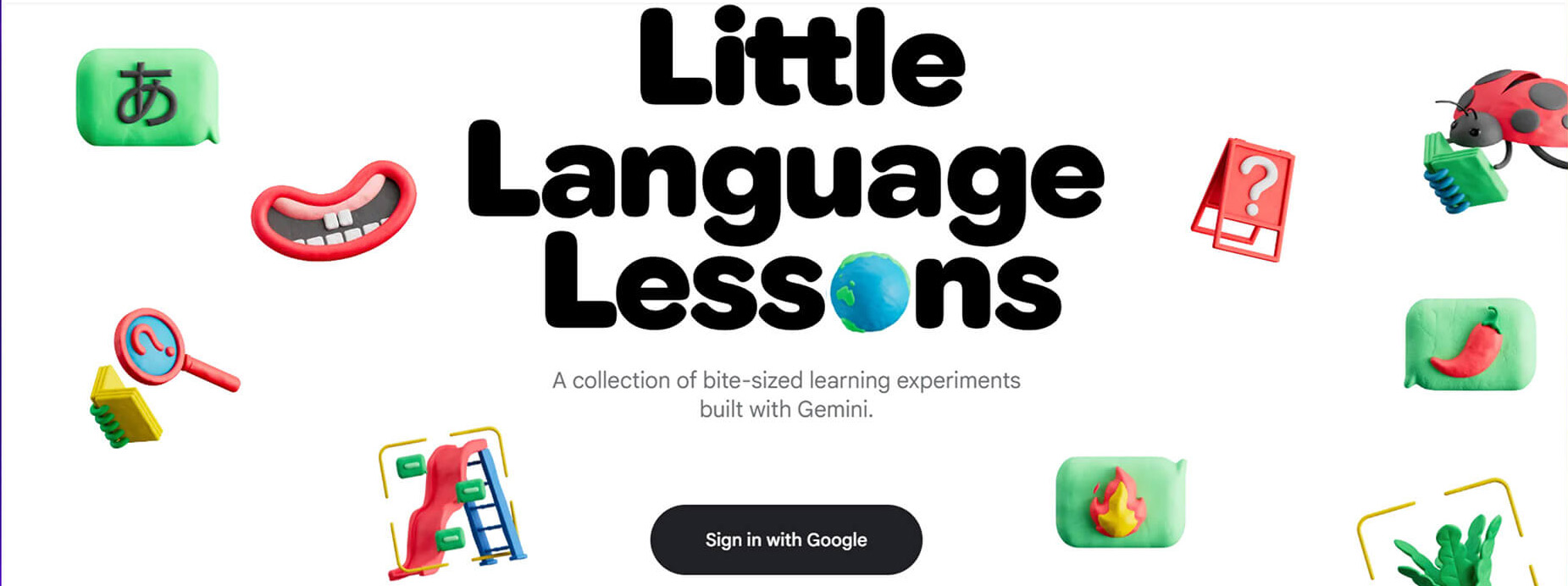
Google Launches New AI Tools to Enhance Language Learning
- Google’s New AI Language Tools
- Overview of Google's Little Language Lessons
- Conclusion
In April, US-based tech giant Google introduced three new AI-powered language tools called Little Language Lessons, all designed to revolutionize the way people learn new languages by offering more personalized and interactive experiences [1][2]. Launched as Google Labs experiments, these new AI tools are designed to provide language lessons to help users in real-life situations, particularly when traveling in a foreign country [1]. Powered by Google’s Gemini AI, the tools aim to provide the right words and phrases exactly when needed [1]. A one-size-fits-all approach simply will not be sufficient, particularly in situations that require more specific vocabulary and cultural context [3]. This is especially true when trying to run a business or navigate professional settings across a language barrier, where effective communication depends on much more than just basic phrases [3]. In this article, we'll explore the features of these innovative tools and how they aim to transform the way we approach language learning.
Google's experimental Little Language Lessons platform, Tiny Lesson, Slang Hand, and Word Cam, each offer unique functionalities designed to address different aspects of language learning. Let's take a closer look at each of them:
Tiny Lesson
The first experiment in the Little Language Lessons, Tiny Lesson, is designed to help learners build vocabulary and contextual understanding in a new language [4]. It provides two interactive input boxes: one for selecting the language of interest and another for entering a specific theme or topic, limited to 50 characters [4]. After choosing the target language, users are prompted to describe the action or purpose for which they need help, such as submitting phrases like "finding the restroom," "taking a taxi," or "I need a doctor" [2]. The tool will generate a list of relevant words for the chosen language [4]. Each word comes with a pronunciation guide, its meaning, and audio to help with proper pronunciation. Full sentences are presented alongside their meanings and audio, providing context for usage, tenses, and how the words fit into various scenarios [4].
Slang Hang
The second experiment, Slang Hang, focuses on helping users understand regional slang. It teaches common expressions, idioms, and local phrases through an AI-generated conversation between native speakers [2]. Many learners speak too formally because textbook lessons rarely cover local expressions or casual slang [2]. Slang Hang is designed to teach colloquial language, helping users better blend in with native speakers [2]. Users can choose a country, and the tool will generate a conversation between two fictional characters using slang terms that are common in that country [4]. By clicking on the slang words, users are provided with detailed explanations of their meanings and context, helping them understand how these terms are used in everyday conversation. However, Google has warned that this tool can be prone to AI hallucinations, which means it might sometimes generate slang that doesn't exist or misinterpret the meanings of specific terms [4]. As a result, users should double-check any slang terms before attempting to use them in conversation.
Word Cam
The third experiment, Word Cam, offers a practical feature similar to Google’s image translation tool, enabling users to translate text from images. Users can take a photo of text in a foreign language, and the tool will provide translations for various visible objects in any image [4]. What sets this tool apart is that, instead of simply translating the text, it identifies different objects within the photo and provides corresponding terms in the selected language for each visible item. This feature can be useful for contextual learning, as it helps users associate words with real-world objects and scenarios, making it easier to remember and apply the new vocabulary in practical situations [4].
All three tools can be accessed via Google Labs and support a wide array of languages, including Arabic, Chinese (China, Hong Kong, Taiwan), English (Australia, U.K., U.S), French (Canada, France), German, Greek, Hebrew, Hindi, Italian, Japanese, Korean, Portuguese (Brazil, Portugal), Russian, Spanish (Latin America, Spain), and Turkish [2].
With Tools like Tiny Lesson, Slang Hang, and Word Cam, Google offers a highly personalized and interactive approach that goes beyond traditional methods. These tools aim to meet learners exactly where they are—whether they’re picking up basic vocabulary or trying to grasp local slang. With broad language support and an emphasis on real-world application, Google’s latest innovations could reshape how we learn and use new languages in our increasingly interconnected world. While still in the experimental stage and not without limitations, such as potential AI inaccuracies in slang interpretations, the tools signal a promising future where AI supports more immersive and effective language learning. Google’s new approach could also reshape how learners of all levels engage with new languages, offering a more intuitive, responsive, and accessible path to communication across borders.
Notes and References
- Malik, A. (2025, April 29). Google Launches AI Tools For Practicing Languages Through Personalized Lessons - TechCrunch. https://techcrunch.com/2025/04/29/google-launches-ai-tools-for-practicing-languages-through-personalized-lessons/
- Whitney, L. (2025, April 30). New Google Labs Experiments Help You Learn New Languages In “bite-sized” Lessons - ZDNET. https://www.zdnet.com/article/new-google-labs-experiments-help-you-learn-new-languages-in-bite-sized-lessons/
- Zetlin, M. (2025, May 1). I’m an Amateur Linguist and I Tried Google’s New AI Language Lessons. 1 Feature Could Be a Game-Changer - Inc. https://efcnetwork.org/ai-in-water-management-six-ways-artificial-intelligence-can-help-solve-problems-across-the-water-sector/
- Hughes, A. (2025, April 30). Google’s New Ai Language Tool Could Change How We Learn Languages — And Duolingo Should Be Worried - Tom’s Guide. https://www.tomsguide.com/ai/googles-new-ai-language-tool-could-change-how-we-learn-languages-and-duolingo-should-be-worried
